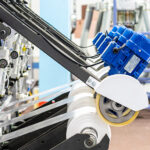Contributed by Justin Fluegel
An electro-pneumatic pressure regulator is an ideal option to control the force, tension, or torque within a system. The pressure within a system directly correlates to the amount of force available to the actuator — lower pressure results in a lower force and vice versa. For the controller to regulate the amount of force in the system, the critical input for the controller to regulate the amount of force in the system is feedback to adjust the valve position. This adjusts the output force.

To control the force output of a pneumatic linear actuator, it is important to have a feedback into the system so the controller can adjust the electropneumatic relief valve’s pressure output. A load cell is a common option to provide the force on an object. For example, if the pneumatic cylinder is used on a bottling line with different bottles, as the bottle geometry or material changes and the force required to clamp the bottle varies, the force could be adjusted as the bottle could press against a load cell.
Tension is another variable that the electropneumatic pressure regulator can precisely control. Imagine a roll of cardboard being wound from a process line. A pneumatic cylinder is applying the force on the idler bar maintaining the tension of the cardboard wrapping around the spool. Using a linear variable displacement transducer (LVDT), connected to the linkage on the cylinder provides the controller the location of the cylinder. If additional force is required, the LVDT would be providing the controller a signal showing the cylinder is retracting and as the electropneumatic pressure relief is increased, the cylinder would have additional force and extend to the position required.
Controlling the torque output of a system utilizing an electropneumatic pressure regulator requires feedback. Depending on the application, a strain gauge provides an option; otherwise a torque sensor needs to be incorporated into the machine design. Going back to the bottling line with a variety of bottle sizes from the force control, it is safe to assume the threads and diameters on the opening to the bottle would vary depending on the customer. As these variables would change, the amount of torque required by a pneumatic motor to secure the lid on the bottle would also change. The torque sensor would provide the controller a signal showing the cylinder is retracting and as the electro-pneumatic pressure relief is increased, the cylinder would have additional force and extend to the position required. As the electro-pneumatic pressure regulator adjusts the pressure, the output torque of the motor can be adjusted to the cap torque requirements. This saves our arms and hands from struggling to open a bottle.



Leave a Reply